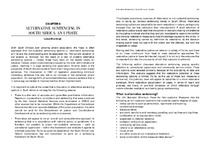| dc.contributor.author | Lukas, Muntingh | |
| dc.date.accessioned | 2019-12-05T13:36:27Z | |
| dc.date.available | 2019-12-05T13:36:27Z | |
| dc.date.issued | 2005 | |
| dc.identifier.citation | Muntingh, L. 2005. 'Alternative sentencing in South Africa: an update' in Maepa, T. Beyond retribution: prospects for restorative justice in South Africa. Institute for Security Studies. 105-119 | en_US |
| dc.identifier.uri | http://hdl.handle.net/10566/5114 | |
| dc.description.abstract | With South Africa’s ever growing prison population, the hope is often expressed that non-custodial sentencing options or ‘alternative sentencing’ will relieve the overcrowding and its associated ills. The current situation in our prisons is, however, not the result of a lack of creative alternative sentencing options – indeed, these have been on the statute books for decades. Instead, prison overcrowding is caused by the slow administration of justice, resulting in a large awaiting trial population. Another factor is the propensity of South African courts to hand down long prison and prison-based sentences. The introduction in 1997 of legislation prescribing minimum mandatory sentences has also led to an increase in the sentenced prison population. On average 62% of convicted offenders receive a sentence that is in some way connected to imprisonment or direct imprisonment. | en_US |
| dc.language.iso | en | en_US |
| dc.publisher | Institute for Security Studies | en_US |
| dc.subject | non-custodial sentencing | en_US |
| dc.subject | UN standard minimum rules for non-custodial measures | en_US |
| dc.subject | Reintegration | en_US |
| dc.subject | Correctional supervision | en_US |
| dc.subject | Community service orders | en_US |
| dc.title | Alternative sentencing in South Africa: an update | en_US |
| dc.type | Book chapter | en_US |

